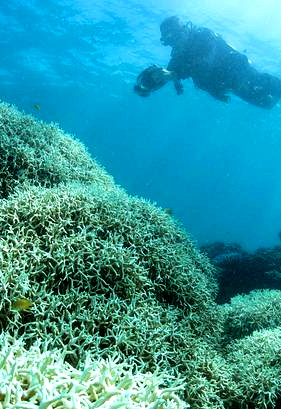Annual bleaching looms
 The world's tropical coral reefs are approaching a tipping point of ‘near-annual’ bleaching.
The world's tropical coral reefs are approaching a tipping point of ‘near-annual’ bleaching.
Rising ocean temperatures could see coral bleaching become a near-annual event, according to Dr Mark Eakin, coordinator of Coral Reef Watch at the National Oceanic and Atmospheric Administration (NOAA).
Tropical coral reefs tend to experience the worst bleaching during the Pacific Ocean’s El Niño phase, however, the latest bleaching on the Great Barrier Reef hit during this cycle’s neutral phase.
“The real concern is with this much bleaching without tropical forcing,” Dr Eakin has told reporters.
“This may be a sign we’ve now tipped over to near-annual bleaching in many locations.
“It’s quite concerning that we are getting this much heat stress across the Great Barrier Reef in an Enso [El Niño southern oscillation]-neutral year.
“What we are seeing on the Great Barrier Reef and potentially elsewhere is really being driven just by anthropogenic climate change.
“If we get another El Niño, the odds are almost 100 per cent that we will see another global bleaching event.”
Aerial surveys of 1,020 individual reefs across the 2,300km length of Great Barrier Reef marine park have confirmed a third mass bleaching event in only five years.
“That’s already pushing awfully close to near-annual bleaching,” Dr Eakin said.
His team says modelling for the next four months shows a “classic pattern of heat stress” that often precedes global bleaching events.
Heat is predicted to rise first in the southern Indian Ocean, then south-east Asia and into the Coral Triangle.
Dr Eakin said a global bleaching event “would not really surprise me”.
The Australian Institute of Marine Science says it is monitoring sites to see which corals had survived the most recent bleaching event and how it has impacted recovery from previous bleaching.








 Print
Print